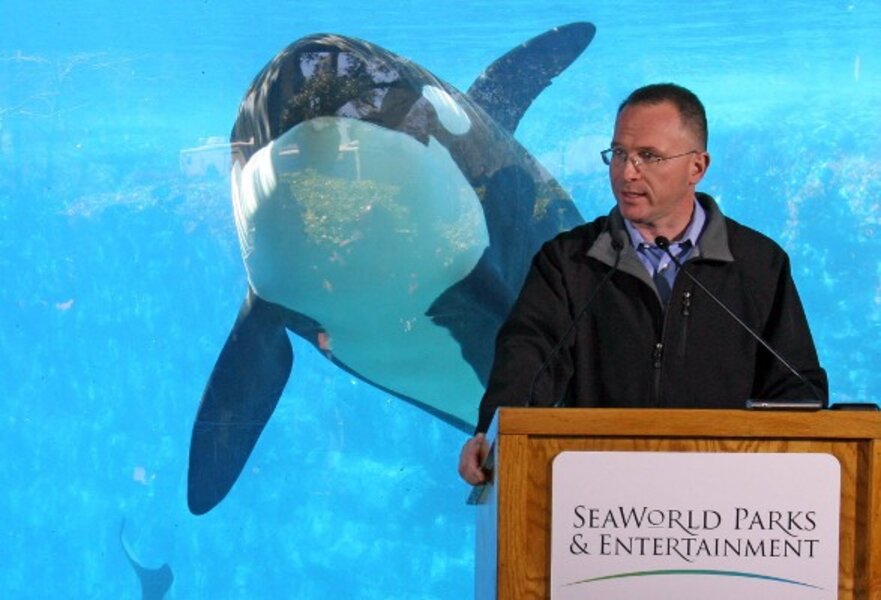SeaWorld defends use of 'Tilikum' and other killer whales
Loading...
| Los Angeles
Two days after a 12,300 pound male orca “killer whale” grabbed a trainer at the Orlando SeaWorld and killed her, park officials are still in damage control mode. But their tactics have changed from defense to offense.
Major animal rights groups – including People for the Ethical Treatment of Animals (PETA), the Animal Legal Defense Fund, the Humane Society of the US, Born Free USA, and others – excoriated SeaWorld for using wild animals in entertainment venues.
SeaWorld officials are openly questioning the motivations of such groups. They're also emphasizing the millions of dollars they spend in outreach, educational, and conservation programs to save animals.
“Criticism of keeping these marine animals in captivity is unfounded,” says Fred Jacobs, vice president of communications for SeaWorld Parks. “There are lots of animal rights groups who exploit a tragedy like this to try to advance their extremist agendas and get their names in the newspapers. We feel that is lamentable.”
Jacobs says careless allegations that surface after an event like this – that captive sea creatures develop ulcers, that echolocation studies cause insanity, that such animals have committed suicide, that they develop stress-induced illnesses – are “absurd.”
He says SeaWorld is subject to two major federal laws – the Animal Welfare Act and the Marine Animal Protection Act – which call for regular inspections. SeaWorld is also a member of the Association of Zoos and Aquariums, which maintains standards. And Jacobs says the park is open to 12 million visitors a year, who can inspect the quality of care.
Polls show visitors approve of whale shows
To answer criticisms that theme parks such as SeaWorld are only interested in making money and not in animal welfare and education, Jacobs quotes regular polls that show that more than 90 percent of respondents support zoological display of marine animals.
An online poll by Harris Interactive in 2005 showed that 97 percent agree that marine parks play an important part in educating the public, and 96 percent agree that they provide valuable information about waters, oceans, and the animals that live there.
A Roper/Starch poll in 1998 found that 94 percent of park visitors said they learned “a great deal” about marine animals, and 97 percent said that their personal experience with such animals was greater when they could interact up close. (Do killer whales belong in theme parks? More here.)
SeaWorld President and CEO Jim Atchison was in front of cameras Friday, answering tough questions from reporters who wanted to know if training protocols had been broken in the Orlando SeaWorld incident, whether or not it is time to retire the orca, and if there are any tributes planned for the trainer who was killed.
He said they are currently editing a tribute to veteran trainer Dawn Brancheau for Saturday’s 11 a.m. show. He said it “would be a shame” to retire Tilikum: “This is really a wonderful animal. His participation in shows is an important part of his life and husbandry.”
SeaWorld parks expected to change training and performing
Atchison said that SeaWorld would be analyzing the park’s training and performing protocols; he assumes the parks will make changes, but declined to give details. (How common are killer whale attacks? Monitor report.)
Meanwhile, Julie Scardina, SeaWorld and Busch Gardens animal ambassador, is reminding reporters that SeaWorld’s entire mission from its founding in 1964 has been to support animal health, veterinary, reproductive, and physiology programs worldwide. It has rescued more than 15,000 large marine mammals – not fish but seals, manatees, dolphins, sea lions, and whales. It also gives worldwide grants to rescue efforts.
The SeaWorld and Busch Gardens Conservation Fund was formed in 2003, and has since given $5.5 million in grants. SeaWorld also has an education department which works with school districts to organize in-class video programs and field trips.
“SeaWorld contributes an incalculable amount to conservation and marine life worldwide, which is, by any measure, extremely significant, both in practical terms and in setting an example for others,” says Steve Feldman, spokesman for the Association for Zoos and Aquariums, an accrediting body that sets standards for animal care and conservation. “They are subject to the highest standards.”





